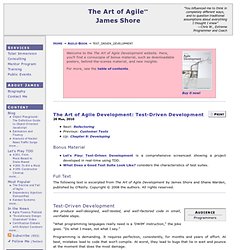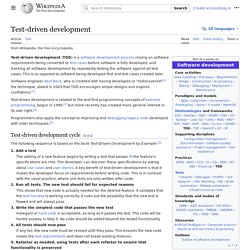

The Art of Agile Development: Test-Driven Development. Bonus Material Let's Play: Test-Driven Development is a comprehensive screencast showing a project developed in real-time using TDD.

What Does a Good Test Suite Look Like? Considers the characteristics of test suites. Full Text The following text is excerpted from The Art of Agile Development by James Shore and Shane Warden, published by O'Reilly. Audience Programmers We produce well-designed, well-tested, and well-factored code in small, verifiable steps. "What programming languages really need is a 'DWIM' instruction," the joke goes. Programming is demanding. People aren't so good at perfection. Wouldn't it be cool if there was a tool that alerted you to programming mistakes moments after you made them—a tool so powerful that it virtually eliminated the need for debugging? There is such a tool—or rather, a technique. Test-driven development, or TDD, is a rapid cycle of testing, coding, and refactoring. TDD isn't perfect, of course. Why TDD Works After TDD is finished, the tests remain.
Ally. Test-driven development. Test-driven development (TDD) is a software development process that relies on the repetition of a very short development cycle: requirements are turned into very specific test cases, then the software is improved to pass the new tests, only.

This is opposed to software development that allows software to be added that is not proven to meet requirements. American software engineer Kent Beck, who is credited with having developed or "rediscovered"[1] the technique, stated in 2003 that TDD encourages simple designs and inspires confidence.[2] Test-driven development is related to the test-first programming concepts of extreme programming, begun in 1999,[3] but more recently has created more general interest in its own right.[4] Programmers also apply the concept to improving and debugging legacy code developed with older techniques.[5] Test-driven development cycle[edit] A graphical representation of the test-driven development lifecycle 1. 2. Guidelines for Test-Driven Development. Jeffrey Palermo MCSD.NET May 2006 Summary: Find out how to incorporate Visual Studio Team System into test-driven development practices emphasized in Agile development methodologies. (3 printed pages) Contents Introduction Test-driven development (TDD) is an advanced technique of using automated unit tests to drive the design of software and force decoupling of dependencies.

The motto of test-driven development is "Red, Green, Refactor. " Red: Create a test and make it fail. The Red/Green/Refactor cycle is repeated very quickly for each new unit of code. Process Example When you use Visual Studio Team System, the following steps can be performed while you are processing a work item that is already assigned to you. Make sure that you have a VSTS Test Project in your solution available for creating new tests. Follow these steps (slight variations exist among TDD practitioners): Understand the requirements of the story, work item, or feature that you are working on. Conclusion See Also. Introduction to Test Driven Design (TDD) Test-driven development (TDD) (Beck 2003; Astels 2003), is an evolutionary approach to development which combines test-first development where you write a test before you write just enough production code to fulfill that test and refactoring.

What is the primary goal of TDD? One view is the goal of TDD is specification and not validation (Martin, Newkirk, and Kess 2003). In other words, it’s one way to think through your requirements or design before your write your functional code (implying that TDD is both an important agile requirements and agile design technique). Another view is that TDD is a programming technique. As Ron Jeffries likes to say, the goal of TDD is to write clean code that works. Table of Contents 1. Figure 1. I like to describe TDD with this simple formula: TDD = Refactoring + TFD.
TDD completely turns traditional development around. Note that Figure 2 assumes that you're doing both, although it is possible to do either one without the other. 2. 3. 4. Test-driven development.